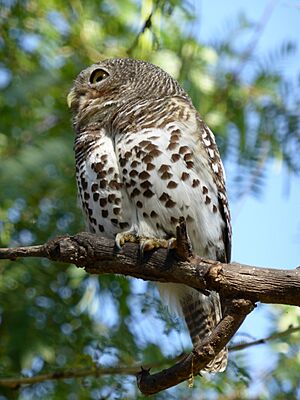African barred owlet facts for kids
Quick facts for kids African barred owlet |
|
|---|---|
 |
|
| In Kruger National Park, South Africa | |
| Conservation status | |
| Scientific classification |
The African barred owlet (Glaucidium capense) is a small type of owl. It lives in many parts of southern, central, and eastern Africa. Scientists sometimes think there might be four different kinds of this owl, not just one.
Contents
What Does the African Barred Owlet Look Like?
The African barred owlet is a small bird. Its look can change a bit depending on where it lives. The most common type is greyish-brown on top. It has thin, light brown stripes and a small white line above its eye.
Its shoulder feathers and larger wing feathers have white edges. These create a white stripe across its shoulder when its wings are folded. The chest is brown with thin light brown stripes. Its belly and sides are white with brown spots. The feathers under its wings, its legs, and its bottom are white. Its flight feathers and tail are brown with reddish-brown stripes.
The owl's beak and the skin above it (called a cere) are a dull greenish-yellow. Its eyes, legs, and feet are yellow. This owl is about 17 cm (6.7 in) long. Its wings can spread out to about 40 cm (16 in).
What Sound Does It Make?
The African barred owlet makes a call that sounds like a series of soft, purring notes. Each note has the same pitch.
Where Does This Owl Live?
The African barred owlet lives only in southern and Eastern Africa. You can find it from Kenya all the way down to the Eastern Cape in South Africa. It also lives in western Angola.
This owl likes places with open spaces and trees. This includes areas like gallery forest (forests along rivers), woodlands, and the edges of forests. It also lives in areas where new trees are growing after old ones were cut down.
How Does the African Barred Owlet Live?
The African barred owlet is active during part of the day. This means it doesn't just hunt at night like many owls. It often calls at dusk and dawn. It also calls throughout clear, calm nights. You can often see it sitting on open branches, looking for food, even when the sun is out.
During the day, it rests hidden in trees. It often uses a natural hole in a tree. If other birds see it during the day, they might try to scare it away. This is called mobbing.
The African barred owlet eats small animals. These include small mammals, birds, reptiles, frogs, and insects. It also eats scorpions and caterpillars. It usually catches its food by flying a short distance from where it was sitting.
Both male and female owls call to show where their territory is. They do this most often before they start breeding. They usually build their nest in a tree hole. This hole is often about 3–6 m (9.8–19.7 ft) above the ground.
The female owl lays two or three eggs. This happens from September to November. Both parents feed the young owls. They only feed them when it's dark. The young owls learn to fly after 30 to 33 days. They become fully independent after 7 to 12 months.
Different Kinds of African Barred Owlets
Scientists currently recognize three main types, or subspecies, of the African barred owlet. Some experts even think each of these types should be considered its own separate species. These types are:
- Glaucidium capense capense: This type lives in southern Mozambique and down to Kwazulu-Natal and the Eastern Cape in South Africa.
- Glaucidium capense ngamiense: This type is found from eastern Democratic Republic of the Congo to central Tanzania (including Mafia Island). It also lives south to Angola, northern Namibia, northern Botswana, Zimbabwe, and Mozambique.
- Glaucidium capense scheffleri: This type lives in the very southern coastal part of Somalia, eastern Kenya, and northeastern Tanzania.


